The variety of rose species and varieties is huge - the only thing they have in common is their beauty. We introduce you to the most beautiful and popular classes of roses.

roses (pink)are a classic in the home gardens. Maybe you've thought about getting your own specimen, but couldn't decide due to the huge selection of varieties. After all, the chosen one should not only correspond to the personal taste of the flower color and shape, but also cope with the conditions in the garden. In rougher locations, for example, you should attach great importance to the weather tolerance, winter hardiness and robustness of the plant. Depending on the intended use, the growth form and flowering behavior are also important decision-making criteria.
contents
- bed roses
- shrub and bush roses
- climbing roses
- miniature roses
- Hybrid Tea Roses
- wild roses
- Historical roses
- groundcover roses
- tree roses
- fragrant roses
- English roses
- ADR roses
The many different varieties are assigned to individual classes of roses, which in turn can be grouped together. However, there may be some overlap here. In order to give you an overview of the variety of roses, we would like to briefly explain the differences between the individual rose classes and groups. We also present some of the most beautiful varieties in a quick run-through for each category.
bed roses
Many different varieties are summarized under the term "bed roses". In addition to the large-flowered hybrid tea roses, this also includes the cluster-flowered floribunda and polyantha roses. Regular pruning keeps the bed roses low and they can be planted in groups or over large areas in the garden.
We find the following types of bed roses particularly beautiful:
-
'Bonica '82'
Robust variety with light pink flowers from June to September; can train rose hips; luxuriant growth; grows up to 80 cm high; rainproof and frost hardy -
'Greetings to Aachen'
First Floribunda Pink; double, creamy-white flowers; yellowish-pink in the center; delicate fragrance; bushy growth (height up to 90 cm); hardy -
'Friesia'
Medium-sized, golden yellow flowers; pleasant smell; long and rich flowering; upright growth; many branches; grows about 60 cm high; good weather resistance -
'Sirius'
Semi-double flowers in apricot to creamy white; flowering size; bushy, upright growth; very good leaf health; was awarded the ADR Rose in 2013; hardy -
‘La Sevillana’
Semi-double flowers of bright red colour; delicate fragrance; forms orange rose hips; grows up to 80 cm high; good leaf health; heat tolerant
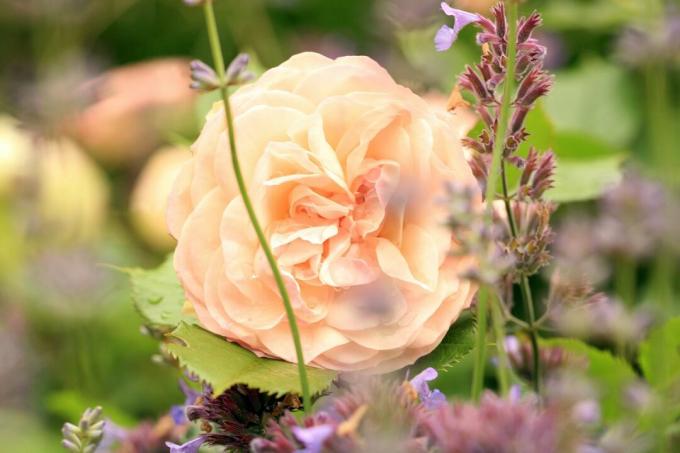
A comprehensive article with Varieties of florets you'll find here.
shrub and bush roses
When you think of roses, you often have a richly flowering bush in mind. According to the growth form, these are so-called shrub roses. They can be used in a variety of ways in the garden and are also particularly easy to care for. While small shrub roses (ground cover roses) only reach a height of about 100 centimeters, large shrub roses can sometimes reach a height of up to 250 centimeters. Therefore, many varieties can also be used wonderfully for hedges or as background planting.
Here is a selection of small shrub/bush rose varieties (height from 100 to 150 cm):
-
'Angela'
Small, semi-double, dusky pink flowers; blooming often; grows compact; reaches heights of about 80 to 120 cm; good leaf health; hardy; suitable for pot planting -
'Belvedere'
Double apricot-orange flowers; blooming often; bitter scent; reaches heights of about 120 to 150 cm; medium leaf health; Flowers are long lasting -
'Peace Light'
Very double, creamy-white flowers; blooming often; light fragrance; upright, slightly arching habit; grows about 120 to 150 cm high; pretty tough; rainproof flowers; frost hardy -
'Hercules'
Densely filled, lavender-colored flowers; blooming often; smells of pear; upright, bushy growth with overhanging shoots (about 100 to 140 cm high); robust; hardy -
'Rhapsody in Blue'
Semi-double, purple-violet flowers with a white center; blooming often; light fragrance; upright, bushy habit (up to 120 cm high); medium leaf health

If there is enough space in the garden, the following shrub rose varieties are also suitable for planting in the bed (height from 150 to 200 cm):
-
'bonanza'
Semi-double flowers in yellow with a reddish edge; blooming often; delicate fragrance; upright, bushy growth; reaches heights of about 150 to 200 cm; very good leaf health; frost hardy -
'Eden Rose 85'
Very double flowers from white-pink to a strong pink; blooming often; slightly fruity fragrance; bushy growth; reaches heights of up to 200 cm; rainproof and heat tolerant -
‘Ghislaine de Feligonde’
Small, double flowers from soft yellow to creamy white; blooming often; elegant fragrance; strong, overhanging growth; grows about 150 to 200 cm high; good leaf health; hardy -
'Nevada'
Slightly double flowers in creamy white; once blooming; arching overhanging growth (up to 220 cm high); robust; frost hardy; suitable for single stands or mixed shrub hedges -
'Westerland'
Semi-double blooms of bright copper-orange; blooming often; good smelling; upright, bushy growth; grows up to 180 cm high; good leaf health; for sunny locations

A comprehensive collection of the most popular Shrub varieties can also be found here.
climbing roses
Climbing roses are characterized by their vigor and their particularly long shoots. Within the rose class, the climbing roses are subdivided again: Real climbing roses bloom several times a year and reach a height of about three meters. In contrast, rambler roses form very elastic shoots that can reach a length of up to ten meters. They are particularly suitable for growing over pergolas or rose arches. But not only in the growth habit, but also in the flower shape and color there are sometimes very big differences within the rose class.
Below we would like to present a small selection of climbing rose varieties:
-
'aloha'
Very double flowers in apricot; intense fragrance; blooming often; grows about 220 to 280 cm high; very good leaf health; conditionally hardy - winter protection recommended -
'Jasmine'
Numerous double flowers in pink to violet; blooming often; intense scent of apple; reaches heights of growth of up to 300 cm; hardy -
'Laguna'
double flowers in pink; blooming often; strong, fruity fragrance; grows about 220 to 280 cm high; good leaf health (ADR rose); hardy -
'Moonlight'
Semi-double flowers in lemon yellow; blooming often; strong, fruity fragrance; grows up to 250 cm high; good leaf health; hardy -
'New Dawn'
Double flowers in a delicate mother-of-pearl pink; blooming often; light fragrance; reaches heights of growth of up to 350 cm; pretty tough
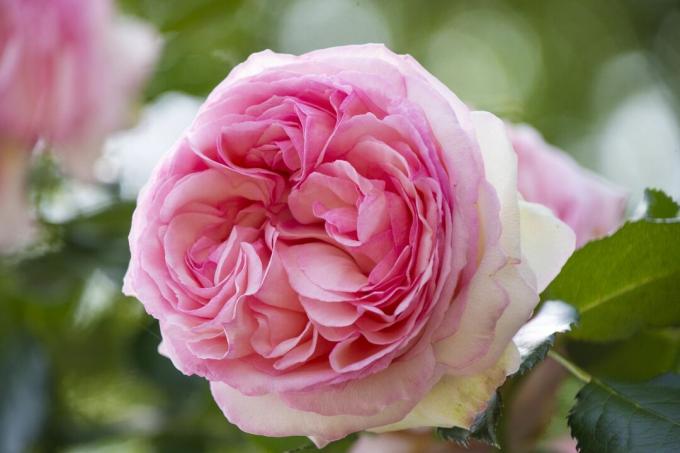
A review article on Planting, care and pruning of climbing roses have prepared here for you.
More beautiful and sturdy Climbing Rose Varieties can also be found in our special article.
miniature roses
Miniature roses are characterized by their compact growth and are therefore also referred to as miniature roses. Mini roses are only about 30 to 50 cm high and are therefore also suitable for smaller gardens. Due to the small space requirement, they can also be planted in a pot to decorate the terrace or balcony. There is a wide range of different varieties of dwarf roses available on the market.
Perhaps this small selection can serve as inspiration for you:
-
'clementine'
Double apricot-orange flowers; blooming often; good durability of the flowers; upright, bushy growth; suitable for container planting; Winter protection required -
'Mandarin'
Double, orange-pink flowers with a yellow center; blooming often; dense, compact growth; medium leaf health; hardy -
'Mandy'
Blood-red semi-double flowers; blooming often; faint fragrance; bushy growth; good leaf health; conditionally hardy - winter protection recommended -
'Orange Jewel'
Salmon-orange, densely filled flowers in umbels; blooming often; dense, compact growth; medium leaf health; long shelf life of the flowers -
'White Babyflor'
Small, well filled flowers in white; blooming often; compact growth; medium leaf health; ideal for pot planting

Hybrid Tea Roses
Hybrid tea roses originated in the 19th Century from the crossing of frequently flowering Chinese tea roses and European remontant roses. They are therefore often referred to as hybrid teas. Hybrid tea roses are among the oldest modern roses and have brought many positive properties to rose breeding, such as an expanded range of colours, new scents and longer flowering periods. Negative properties of China roses - such as increased susceptibility to rose diseases and the lack of winter hardiness - are hardly of any more today due to the successful breeding work with hybrid tea roses Meaning.
In addition to the well-known red hybrid tea roses, there are also many other color variants.
In the following we would like to introduce you to some particularly beautiful varieties:
-
'Augusta Louise'
Large, peach-colored flowers; fruity sweet scent; strong, upright growth; reaches heights of up to 120 cm; good leaf health; hardy -
‘Gloria Dei’
Also known as 'Madame A. Meilland' or 'Peace' known; loose, light yellow flowers with a pink edge; pleasant smell; bushy growth; grows up to 100 cm high; weatherproof -
'Countess Diana'
Named after Countess Diana Bernadotte; purple-purple flowers; intense fragrance; upright, bushy growth; reaches heights of up to 120 cm; ADR rose; conditionally hardy -
'Pascali'
Medium-sized, pure white flowers in a noble form; delicate fragrance; rich flowering; strong, bushy growth; grows up to 70 cm high; good leaf health -
'Sutter's Gold'
Loose flowers in light orange with a reddish tinge in the edge; strong fragrance; reaches heights of growth of up to 100 cm; medium leaf health
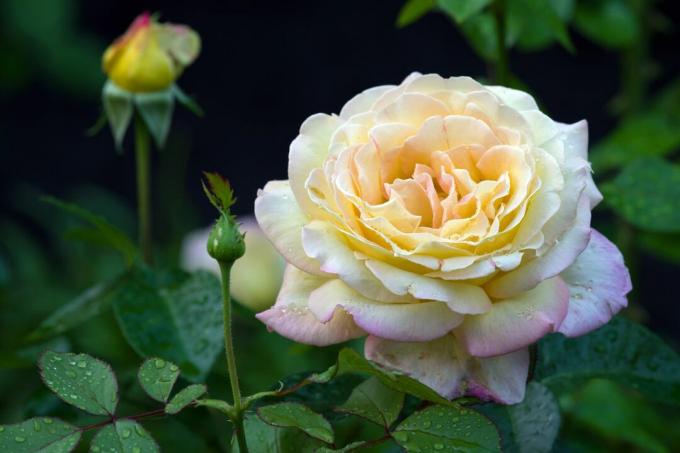
More gorgeous Hybrid Tea Varieties can be found here.
wild roses
All modern cultivated roses descend from the robust wild roses. For ecological reasons alone, it can make sense to fall back on these original species, because the simple flowers serve as a food source for bees and other insects. The fruits (rosehips), which form in late autumn, are in turn readily eaten by birds. But there is also a lot to be said for planting a wild rose from a technical point of view. The wild forms are usually easier to care for and less susceptible to plant diseases than modern varieties.
Perhaps there is already a suitable species for your garden here:
-
Vinegar Rose – Rosa gallica
Semi-double pink flowers; strong fragrance; upright, bushy habit with overhanging shoots (up to 120 cm high); shade tolerant; high leaf health -
pike rose – Rosa glauca
Cupped, light pink flowers; heavy fruit load from August; foliage shimmering bluish in summer; bushy, upright growth; grows 150 to 250 cm high; pretty tough -
Chinese Gold Rose – Pink hugonis
Small flowers of light golden yellow; blooms as early as May; black-red rose hips; broad, bushy, overhanging growth (up to 200 cm high); conditionally hardy -
Tufted Rose – Pink multiflora
Numerous small flowers of white; strong scent of honey; forms rounded hips; upright growth with arching overhanging shoots; grows up to 300 cm high; hardy -
wine rose – Rosa rubiginosa
Single flowers of light crimson pink; Leaves smell like apple or wine; upright growth with overhanging shoots (up to 350 cm high); strongly pricked
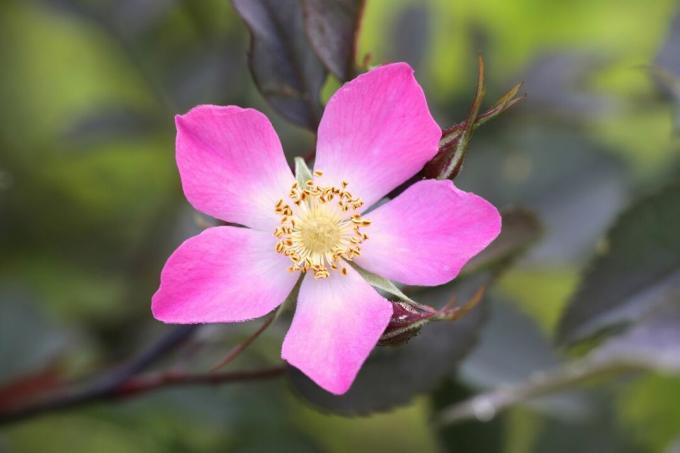
More gorgeous wild rose species as well as tips for pruning wild roses can be found here.
Historical roses
Historic or old roses are the longest cultivated garden roses. These include those roses that were already in cultivation before the introduction of the first hybrid tea in 1867, even if individual varieties only emerged later (e.g. by crossing two varieties of Old Roses). are. Depending on the lineage, within the historical roses, for example, the Gallica-roses, Alba-roses, Damascene-Roses and centifolia are distinguished. Among these main groups, there are mainly varieties that flower once, because varieties that flower more often only emerged in the course of the 19th century. century. The densely filled, fragrant flowers, the stately growth and the pastel coloring of the petals are also characteristic of old roses.
Historical roses include the following varieties:
-
Charles de Mills
Gallica-Rose from 1746; double, purplish-violet flowers; once blooming; strong fragrance; broad, bushy growth; rain and heat resistant; hardy -
‘Gallica officinalis’
Probably the oldest European variety (since 1310); semi-double, pink-red flowers with a strong scent; once blooming; shade tolerant; very good leaf health -
'Mme Hardy'
French breed from 1832; densely filled, pure white flowers with a green eye; once blooming; gives off a strong lemon scent; very healthy; hardy -
'Mme Isaac Pereire'
French breed from 1881; densely filled, crimson flowers; blooming often; strong fragrance; vigorous; medium leaf health; hardy -
'Louise Odier'
Breeding from 1851; densely filled, pure pink flowers; intense fragrance; blooming often; bushy growth with overhanging shoots; Winter protection recommended
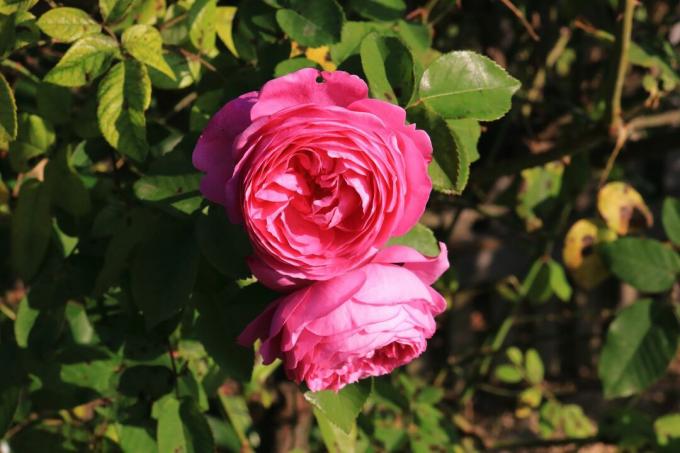
groundcover roses
Ground cover roses are nothing more than low-growing bed or shrub roses, which is why they are often referred to in the trade as small shrub roses. The undemanding perennial bloomers reach heights of growth of about 20 to 100 centimeters and usually inspire with their bloom until autumn. As a rule, ground cover roses are very robust, floriferous and long-lived. They come into their own best when planted in groups of three to five plants per square meter, depending on the vigor of the variety. In combination with tree roses or colour-coordinated perennials and grasses, wonderful beds can also be created.
The following varieties of ground cover roses are particularly popular:
-
'Apple Blossom'
Single, white flowers in umbels; delicate fragrance; soft, pliable shoots; reaches heights of up to 80 cm; high leaf health -
'Gardener's Delight'
Also known as 'Toscana'; small, double flowers in raspberry red; flat growth; reaches heights of growth between 40 and 50 cm; very easy to care for; good leaf health; hardy -
'pagan dream'
Numerous, crimson flowers; lightly scented; bushy growth (up to 80 cm high); hardly any maintenance necessary; flowers are rain-hardy and heat-tolerant; good leaf health -
'Mainau Fire'
Blood-red, loosely filled flowers; wide, upright growth; reaches heights of up to 60 cm; robust variety with good long-distance effect; hardy -
'The Fairy'
Small, double, salmon-pink flowers; broad, bushy growth (up to 80 cm high); heat tolerant; good leaf health; suitable for embankments and slopes
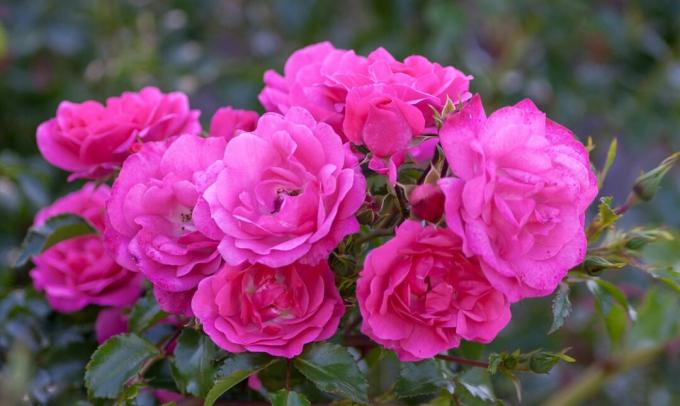
Wmore beautiful Ground Cover Rose Varieties you can discover here.
tree roses
Strictly speaking, standard roses always consist of two varieties. Because most roses naturally do not form trunks, which is why blooming bedding or hybrid tea roses are grafted onto specially cultivated wild rose shoots. Depending on the trunk height, one and the same variety is offered as a dwarf standard rose (up to 50 centimetres), a half standard rose (up to 70 centimetres) and/or as a standard rose (about 90 centimetres). So-called cascade standard roses are varieties of climbing or rambler roses that have been grafted onto wild roses. These usually form long, overhanging shoots and reach trunk heights of about 120 to 140 centimeters.
Here is a small selection of beautiful standard roses in different colours, shapes and sizes:
-
Leonardo da Vinci
Mini standard rose with densely filled, dark pink flowers; flower color hardly fades; delicate fragrance; trunk height of about 50 cm; medium leaf health; hardy -
'Marie Curie'
Half-stem (about 70 cm high) with a compact, bushy crown; depending on the weather, the flowers are colored apricot-orange to pink; pleasant smell; good leaf health; hardy -
'Minerva'
Half-stem (about 60 cm high) with double purple flowers; lovely scent; flowers from early summer to autumn; hardy; suitable for pot planting -
'Golden Else'
Compact standard (about 90 cm high) with double, decoratively wavy dark orange flowers; delicate fragrance; medium leaf health; very good winter hardiness -
'Golden Celebration'
English cascade stem rose (about 140 cm high); magnificent, very double flowers in rich golden yellow; intense berry scent; broad, bushy growth; good leaf health

fragrant roses
The scent of roses not only attracts many insects, but also makes rose lovers go into raptures in the truest sense of the word. However, the selection of fragrant roses is not that large compared to all rose varieties, because unfortunately in the last decades in rose breeding mainly on the appearance, i.e. on the shape and color of the flowers, respected. Many modern rose varieties have very little or no scent. Today, specially bred fragrant roses are often descended from strongly scented wild roses. They are mainly found among the old roses, the English roses, but also among the hybrid teas.
Here is a small selection of popular scented roses:
-
English rose 'Constance Spry'
Popular shrub rose; double, pink flowers with a light edge; intense scent of myrrh; once blooming; upright bushy growth; poor leaf health; hardy -
Hybrid Tea 'Scent Cloud'
Double, coral-red flowers; blooming often; intense hybrid tea scent; bushy growth; good leaf health; Among other things, it has been awarded the World Rose and ADR Rose -
Hybrid tea 'Frederic Mistral'
Large, double flowers of light pink; blooming often; intense fragrance with a hint of lime; strong, upright, bushy growth; medium leaf health; good hardiness -
Rambler rose 'Guirlande d'Amour'
Many semi-double, pure white flowers in clusters; blooming often; sweet scent; reaches heights of up to 4 m; very good leaf health; hardy; suitable for rose arches -
Shrub rose 'Rose de Resht'
Medium-sized, bright red flowers; blooming often; heavy rose scent; compact growth habit; good leaf health; rain and heat resistant; hardy

A comprehensive collection Fragrant rose varieties with special flavors we have prepared for you here.
English roses
The rose class of English roses was coined by the Englishman David Austin. In 1961 he was the first rose breeder to combine the characteristics of beautiful, fragrant Old Roses with those of the modern tea hybrids, which are known for their ability to remount and their wide range of colors, in one variety. To date, many more varieties of David Austin's roses have been added.
We would like to present a small selection of particularly beautiful varieties below:
-
'Abraham Darby'
Double flowers in apricot to yellow-orange; fruity fragrance with a tart base note; shrubby growth with overhanging shoots (up to 200 cm high); easy-care; hardy -
'Graham Thomas'
Double flowers in bright yellow; intense scent of tea roses; upright, bushy growth; reaches heights of up to 200 cm; medium leaf health; heat tolerant; hardy -
'Heritage'
Double, light pink flowers; intense fragrance; well-branched, upright, bushy growth; reaches heights of up to 150 cm; medium leaf health; rainproof flowers; hardy -
'Mary Rose'
double flowers in pink; scent of old roses, almonds and honey; bushy growth; reaches heights of up to 150 cm; heat and rain resistant; easy-care -
'The Pilgrim'
Densely filled, yellow flowers in the middle with a white edge; light fragrance; compact, bushy growth; with trellis up to 350 cm high; medium leaf health; hardy
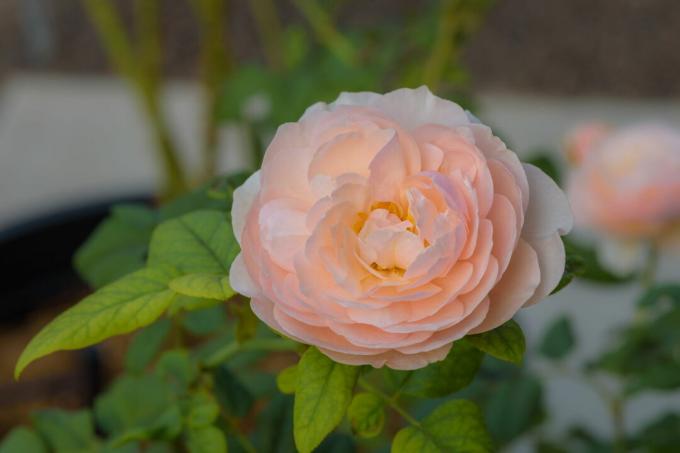
In our special article we provide you with other varieties of English roses and tell you where you can buy particularly beautiful specimens.
ADR roses
The world of roses is enriched by many varieties every year. The General German Rose Novelty Test, ADR for short, was founded in 1950 in order to sharpen awareness of the variety and to be able to assess new breeds appropriately. The working group behind it is made up of representatives of the Association of German Tree Nurseries, rose breeders and independent experts. Since then, the "ADR Rose" award has been given to those new rose varieties that remain healthy when planted in eleven selection gardens and also have a high ornamental value. For example, the effect of the blossom, the scent, the winter hardiness and, last but not least, the resistance to leaf diseases are tested annually over a period of three years. In contrast to other rose awards, however, the ADR predicate can also be withdrawn again due to the stricter test conditions.
Red roses are the absolute classic. We present you the most beautiful ones red rose varieties and their properties.
